Ever wondered how to transform your bedroom into a serene sanctuary that balances simplicity with elegance? Japandi design, a harmonious blend of Japanese minimalism and Scandinavian coziness, has taken the interior world by storm. Its popularity lies in its ability to create calming, clutter-free spaces that feel both modern and warm—perfect for unwinding after a busy day.
This style’s emphasis on natural materials, muted color palettes, and clean lines makes it an ideal choice for anyone seeking tranquility in their personal retreat. In this article, you’ll discover a wealth of inspiring ideas and practical tips to bring Japandi aesthetics into your bedroom.
From sleek, minimalist furniture to soothing lighting and thoughtful decor touches, we’ll cover a variety of design elements that promote calm and balance. Whether you’re starting from scratch or simply looking to refresh your space, these ideas will help you craft a peaceful retreat that exudes understated elegance and comfort.
1. Embrace Minimalist Bed Frames with Clean Lines
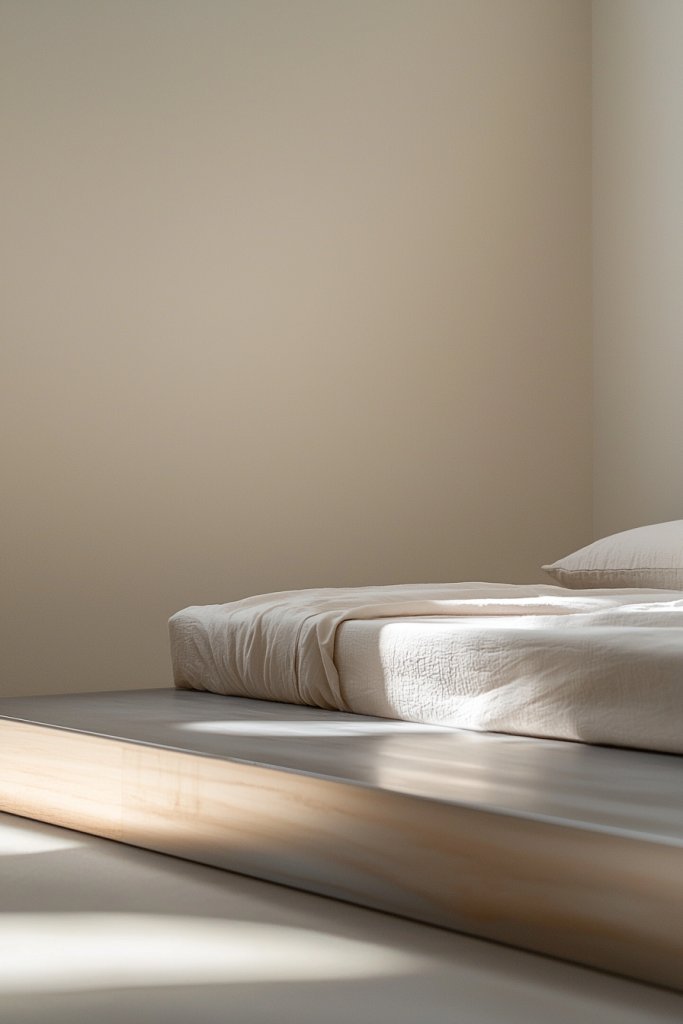
Creating a serene Japandi bedroom begins with choosing the right bed frame—minimalist with sleek, clean lines. This approach strips away unnecessary ornamentation, emphasizing simplicity and functionality, which are core to the style.
A well-chosen bed frame sets the tone for the entire space, fostering calm and order. Imagine a low-profile platform bed crafted from smooth, light-colored wood like maple or oak, with a simple rectangular headboard that’s flush with the frame.
The lines are crisp, and the surface is free of intricate carvings or embellishments. The bed is centered in the room, paired with neutral bedding—think crisp white sheets and a soft beige duvet—creating a visual anchor that promotes tranquility.
The overall look is uncluttered, with enough space around the bed to breathe, encouraging restful sleep and mental clarity. To recreate this look, start by selecting a bed frame with a minimalist design—many modern furniture stores offer options in natural wood or matte finishes.
Keep the bedding simple: opt for fitted sheets in neutral tones and a lightweight duvet or quilt. For added ease, choose a frame with built-in storage or a low-profile design that doesn’t overpower the room’s calm aesthetic. Assembling the bed is straightforward, requiring only basic tools, making it an accessible way to bring Japandi serenity into your bedroom.
2. Opt for Neutral Color Palettes to Enhance Serenity
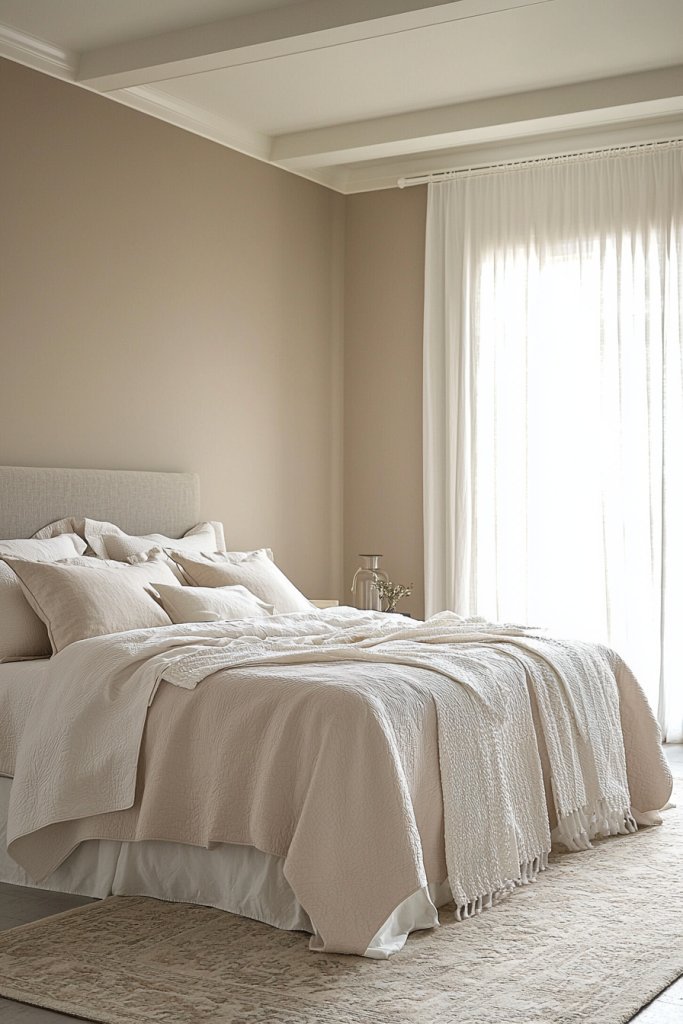
A key element of Japandi design is a soothing, neutral color palette that fosters peace and relaxation. Soft, earthy tones—such as warm beiges, gentle greys, and muted whites—serve as the perfect backdrop, creating a space that feels both calming and timeless.
Visualize a bedroom bathed in natural light, with walls painted in a warm, matte beige. The bedding is a mix of textured linen in shades of soft grey and creamy whites, adding subtle depth without disrupting the sense of calm.
Accents like a woven basket or ceramic vase mirror the neutral tones, while the overall color scheme allows the textures and materials to stand out. The space feels warm and inviting, yet uncluttered, with each element contributing to the tranquil atmosphere.
To achieve this, select paint colors in soft, muted shades—think of shades like “Greige” or “Oatmeal.” Incorporate textiles like linen or cotton in shades that complement the walls, and keep decorative accents in a similar tonal range. When choosing furniture, stick to natural wood finishes and avoid bold or contrasting colors. This understated color palette makes your bedroom feel like a peaceful retreat, perfect for unwinding and restoring energy.
3. Incorporate Low-Profile Platform Beds for a Sleek Look
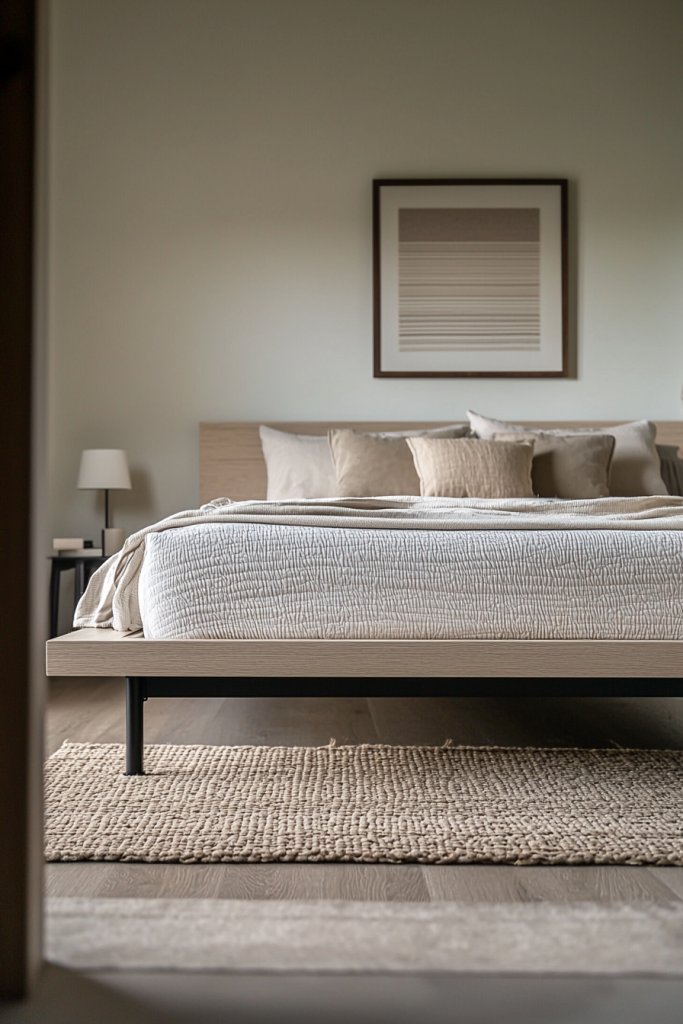
A low-profile platform bed is quintessential to Japandi aesthetics—combining sleekness with a sense of grounded calm. Its minimalist silhouette emphasizes horizontal lines, making the room feel more spacious and uncluttered, while also providing a modern yet cozy vibe.
Picture a bed that sits just inches off the floor, with a flat, unadorned surface made of light or dark wood that complements the room’s neutral palette. The mattress rests directly on the platform without a box spring, creating a streamlined appearance.
Bedding is kept simple: a fitted sheet, a light duvet, and a few textured cushions in neutral shades. The overall effect is a harmonious blend of modern minimalism and natural warmth, with the low height adding to the sense of calm and ease.
To implement this, look for a low-profile platform bed frame—many are easy to assemble and come in various finishes from natural wood to matte black. Pair it with a thin, memory foam mattress for extra comfort without visual bulk.
Keep the bedding minimal and avoid heavy or ornate textiles. This simple addition instantly elevates your space’s aesthetic, making it feel serene, modern, and perfectly aligned with Japandi principles.
4. Use Textured Bedding and Cushions for Cozy Comfort
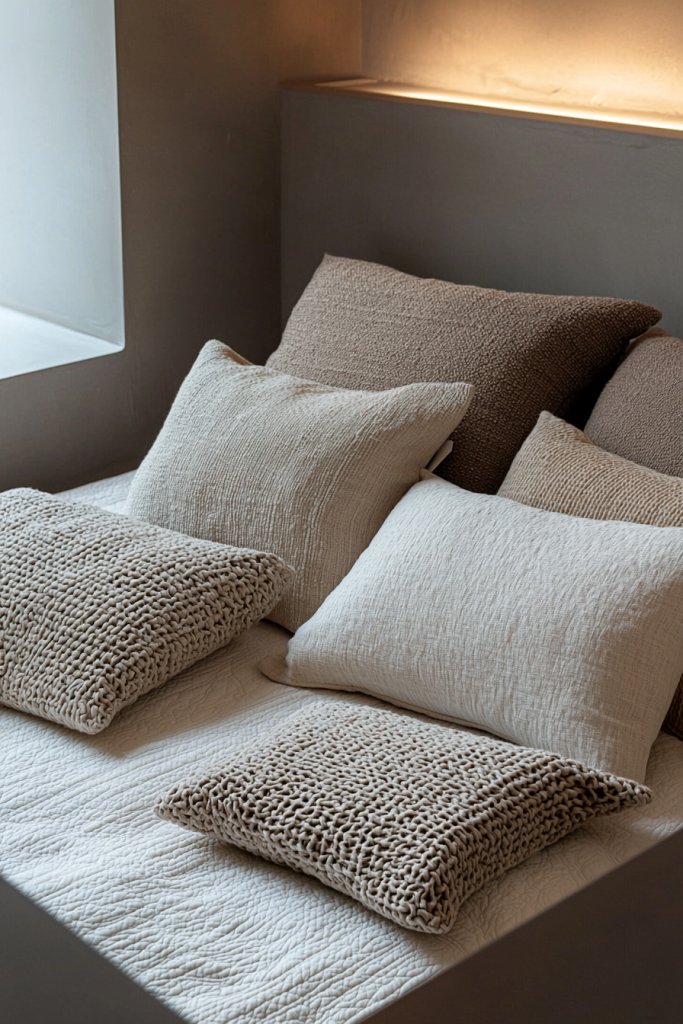
While Japandi design emphasizes simplicity, it also celebrates tactile comfort through layered textures. Using textured bedding and cushions adds warmth and coziness without cluttering the space or disrupting the clean aesthetic.
Picture a soft, cream-colored linen duvet paired with a chunky knit throw in a neutral tone draped across the foot of the bed. Scatter a few cushions in different textures—perhaps a velvet cushion in muted grey, a woven lumbar pillow, and a fleece throw in soft beige—adding visual interest and inviting comfort.
These tactile elements create a cozy, layered look that encourages relaxation and makes the space feel lived-in yet uncluttered. To recreate this, choose bedding made of natural fibers like linen, cotton, or wool, in neutral shades that match your overall palette.
Incorporate cushions with textured covers—think ribbed, woven, or knitted fabrics—to add depth. The key is to balance visual texture with simplicity, avoiding overly bright or patterned textiles. This combination of textures makes the bedroom inviting and warm, perfect for unwinding after a long day while maintaining the serene Japandi vibe.
5. Choose Natural Wood Nightstands to Add Warmth
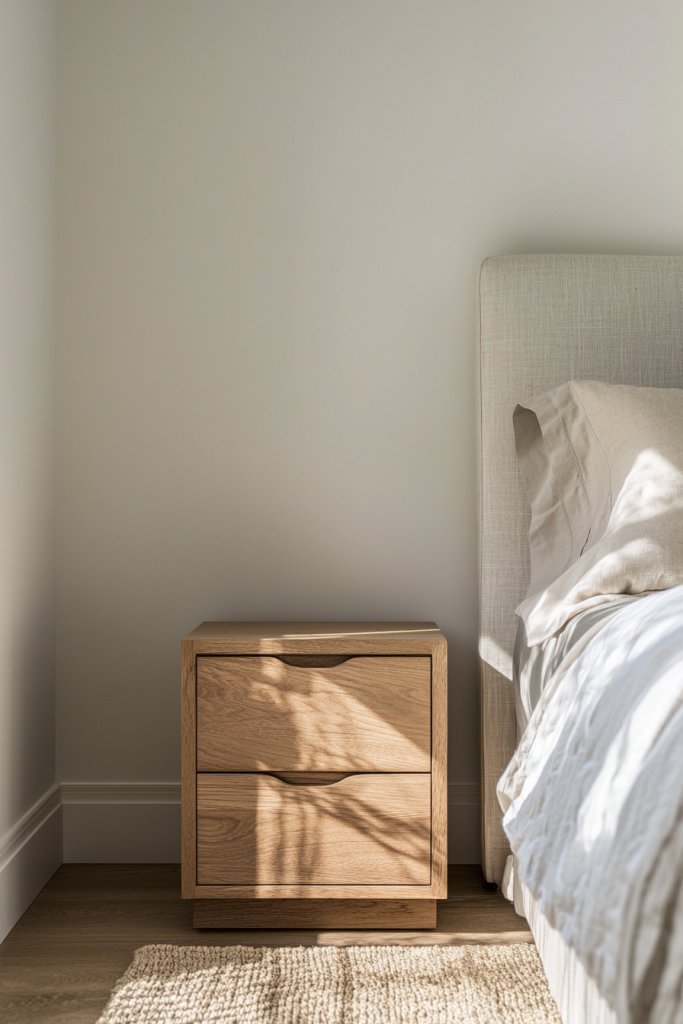
In Japandi bedrooms, natural wood elements bring warmth and a touch of nature indoors. A simple, minimalist nightstand crafted from light or medium-toned wood complements the overall aesthetic while providing functional storage.
Imagine a sleek, rectangular nightstand made of oak or maple, with clean lines and no unnecessary hardware. It sits beside the bed, holding a ceramic table lamp, a small stack of books, and perhaps a simple decorative object like a ceramic vase or a carved wooden sculpture.
The warm wood tones contrast beautifully with neutral walls and bedding, adding depth and organic texture to the room. To achieve this look, select a nightstand in a natural wood finish with a minimalist design—many furniture brands offer options with smooth surfaces and subtle detailing.
Keep accessories to a minimum for a clutter-free appearance: a small lamp, a few personal items, or a decorative object. For budget-friendly options, consider a DIY project using unfinished wood or repurposed furniture. This simple addition enhances the room’s warmth and creates a balanced, inviting space that embodies the harmonious blend of Japandi style.
6. Incorporate Sliding Shoji-Style Doors for Subtle Elegance
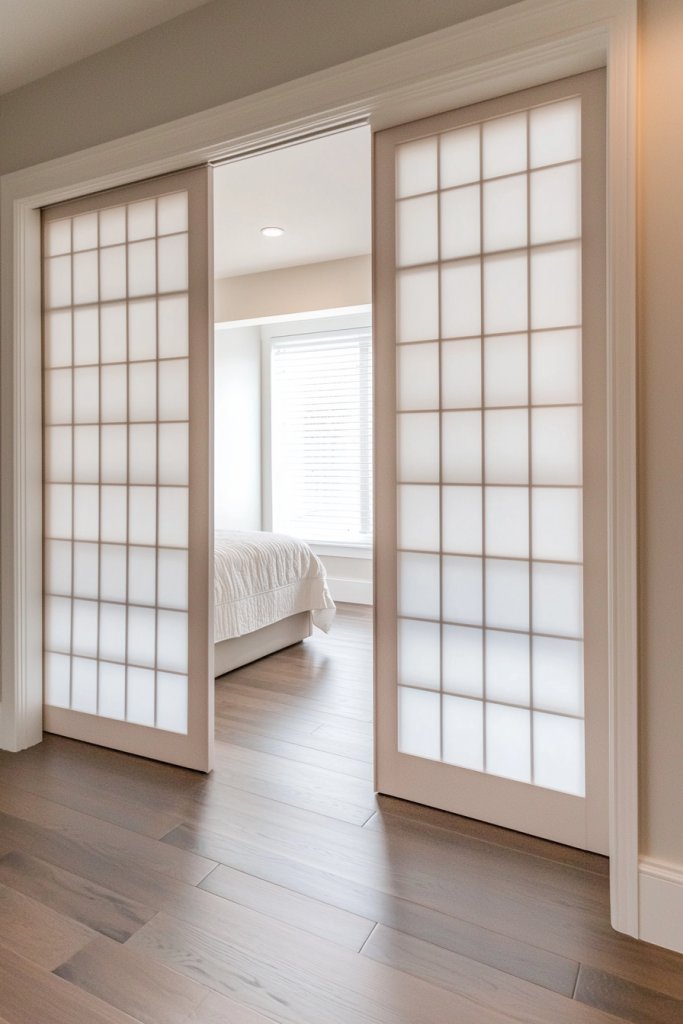
Sliding Shoji-style doors instantly elevate a Japandi bedroom by blending traditional Japanese aesthetics with modern minimalism. Their soft, matte finish and delicate grid pattern create a serene focal point that subtly separates spaces without overwhelming the room.
When closed, they offer a seamless, calm backdrop—light filters through the translucent paper panels, casting a gentle glow that enhances the tranquil atmosphere. Visualize a room where these doors feature natural wood frames in warm oak or ash, paired with semi-opaque rice paper panels.
The doors slide smoothly along a discreet track, revealing or concealing a closet or adjoining space. The soft, muted tones of the wood and paper complement neutral walls and light-colored bedding, while the tactile quality of the materials invites touch.
The overall effect is one of understated elegance, with a calming rhythm to the room’s flow. To incorporate Shoji doors, start by measuring your doorway to select or custom-order sliding panels that fit.
Choose natural wood frames and translucent paper or fabric inserts for authenticity. Install a simple track system, which can often be mounted directly onto existing door frames or walls—many kits are beginner-friendly. Keep the surrounding area uncluttered to maintain the clean, minimalist look, and enjoy the harmonious balance these doors bring to your space.
7. Add Subdued Lighting with Paper Lanterns or Simple Table Lamps

Soft, ambient lighting is key to creating a calming Japandi bedroom, and paper lanterns or understated table lamps are perfect for this purpose. Their gentle glow emits a warm, diffuse light that fosters relaxation and a cozy atmosphere, especially in the evenings.
These lighting options also contribute to the room’s minimalist aesthetic with their simple, elegant forms. Imagine a small, round white paper lantern hanging from the ceiling, casting a soft, even light across the room, or a sleek table lamp with a matte ceramic base and a simple linen shade on a nearby nightstand.
The materials—like rice paper or linen—add texture and visual interest without cluttering the space. The warm light filters through these materials, creating a peaceful, inviting environment that encourages rest and unwinding.
To achieve this look, select paper lanterns in neutral tones or table lamps with minimalist designs—think unadorned ceramic or matte metal bases paired with soft fabric shades. Use warm white bulbs (around 2700K) for a cozy ambiance.
Position the lighting thoughtfully—hang the lantern centrally or place lamps on either side of the bed—to enhance symmetry and balance. Simple dimmer switches allow you to tailor the light intensity to suit your mood.
8. Select Simple, Functional Storage Solutions to Maintain Clutter-Free Space
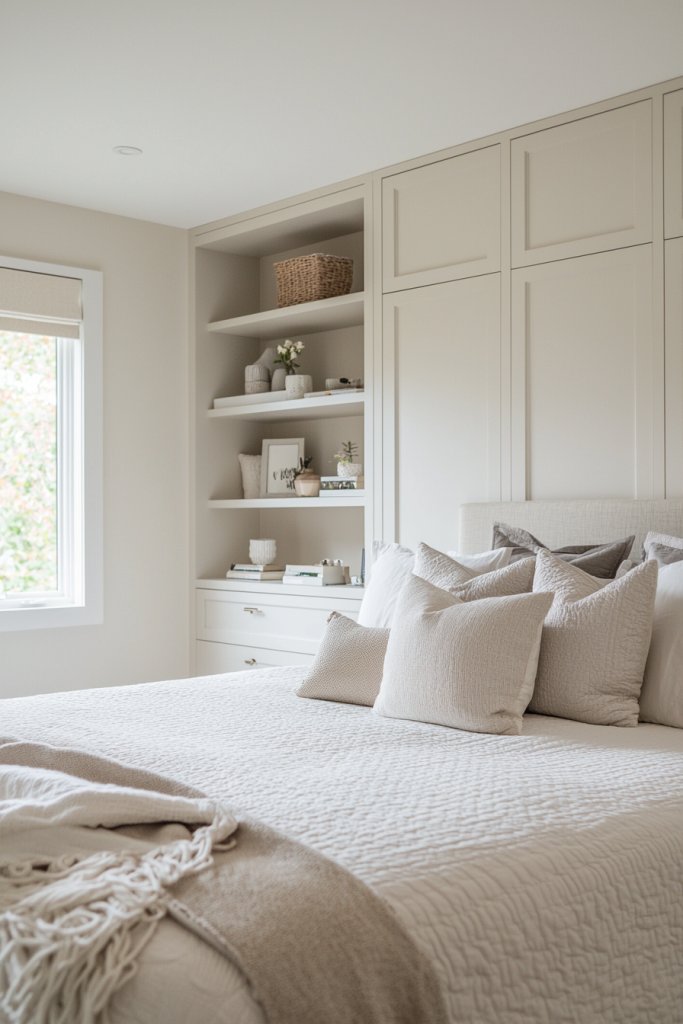
In a Japandi bedroom, clutter creates visual noise that disrupts the sense of calm, making smart storage solutions essential. Choosing simple, functional pieces that blend into the aesthetic helps keep your space serene and organized.
Opt for designs that prioritize clean lines and natural materials, ensuring that storage doesn’t become a focal point but a seamless part of the room. Envision sleek wooden bedside chests or built-in shelves with open compartments for essentials, made from light-toned wood like beech or ash.
Incorporate woven baskets or cotton storage bins inside shelves or under the bed to hide away items, maintaining a tidy appearance. The key is to select pieces that are both beautiful and practical, with minimal hardware or ornamentation.
This approach keeps your room feeling open and uncluttered, emphasizing the calm aesthetic. Start by assessing your storage needs and choosing multi-purpose furniture, such as a bed with built-in drawers or a low-profile storage bench at the foot of the bed.
Keep surfaces clear by using discreet wall-mounted hooks or hidden compartments for daily essentials. Prioritize quality, natural materials, and simple designs, and regularly declutter to sustain the peaceful vibe of your Japandi retreat.
9. Incorporate Soft Area Rugs in Neutral Tones for Warmth Underfoot
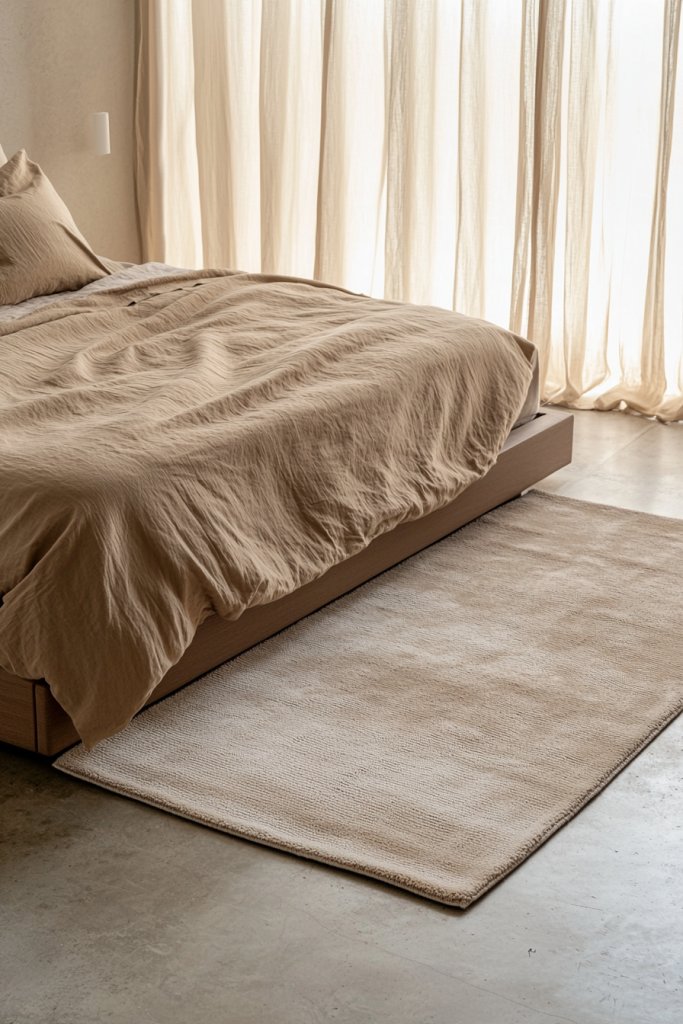
A plush, neutral-toned area rug adds both comfort and visual softness to a Japandi bedroom. It grounds the space and introduces a tactile layer that invites barefoot strolls, reinforcing the room’s cozy, calming atmosphere.
Opting for natural fibers and subtle shades enhances the minimalist aesthetic while adding warmth and texture. Picture a large wool or sisal rug in shades of cream, beige, or light gray, spread beneath the bed, extending outward to create a sense of space.
The rug’s subtle pattern or natural fibers add visual interest without overwhelming the room’s simplicity. Its soft pile cushions your feet as you rise from bed, muffling sounds and contributing to a peaceful environment.
The neutral palette ensures the rug complements other decor elements effortlessly. To incorporate the rug, measure your space and select one that extends beyond the bed’s edges by at least a foot on each side for balance.
Choose materials like wool, jute, or cotton, which are durable and eco-friendly. Place it carefully to define the sleeping area and add warmth, especially in cooler months. Keep the rug clean with regular vacuuming, and choose low-pile options for easy maintenance aligned with the Japandi philosophy of simplicity and functionality.
10. Use Elegant Ceramic Vases and Sculptures as Decorative Accents
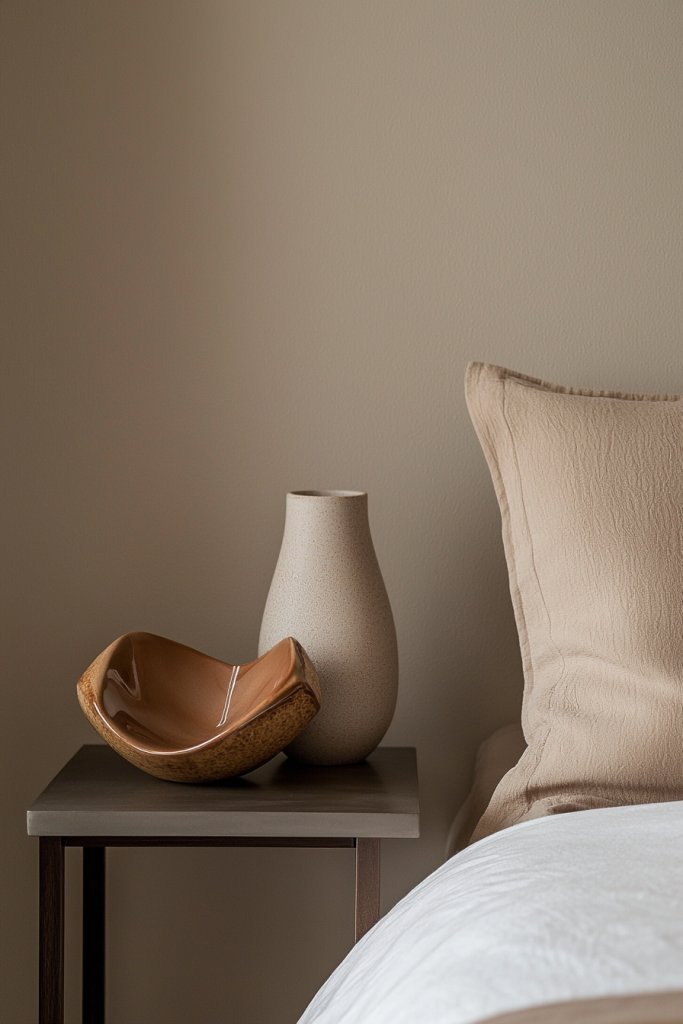
Adding elegant ceramic vases and sculptural accents to your Japandi bedroom instantly elevates the space with a touch of understated sophistication. These carefully chosen decorative pieces serve as focal points that blend simplicity with artistic refinement, embodying the essence of minimalism and natural beauty.
Imagine a sleek, matte white ceramic vase with clean lines sitting on a low wooden bedside table, holding a single dried branch or a delicate sprig of pampas grass. Nearby, a subtle sculpture crafted from smooth stone or matte black ceramic adds texture and visual interest without overwhelming the calm atmosphere.
The color palette remains muted—soft creams, gentle beiges, and muted earth tones—while the textures range from glossy to matte finishes that invite touch. These accents create a harmonious balance, contributing to a serene environment that feels both curated and effortless.
As you enter, the subtle scent of clay and natural materials might gently fill the air, enhancing the calming vibe. To incorporate these elegant ceramic vases and sculptures into your bedroom, start by selecting simple, high-quality pieces in neutral tones that complement your overall color scheme.
You can find beautiful ceramic vases at home decor stores or online, often in shapes like cylinders, urns, or minimalist geometric forms—alternatives include stone or matte metal sculptures for variety. Place them strategically on bedside tables, shelves, or dressers, pairing them with soft textiles like linen throws or woven baskets for added texture.
Keep your arrangement uncluttered, focusing on a few statement pieces to maintain the tranquil, Japandi-inspired aesthetic. With just a few thoughtful choices, you’ll cultivate a peaceful sanctuary that’s both stylish and soothing.
11. Maximize Natural Light with Light, Sheer Curtains
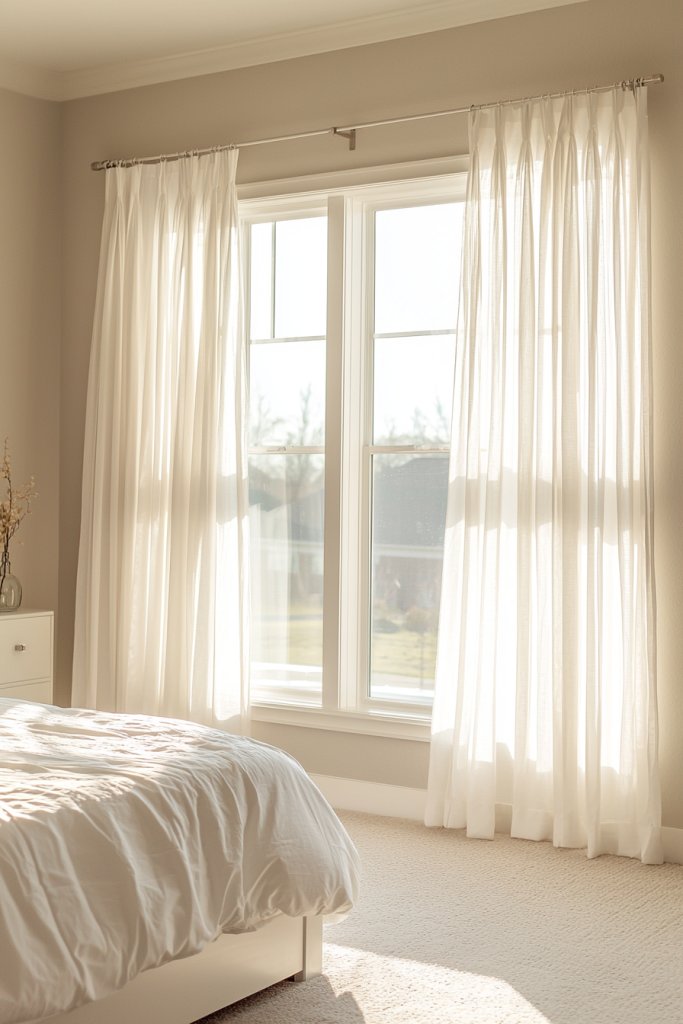
Harnessing natural light is essential for creating a serene Japandi bedroom, making the space feel airy, open, and calming. Light, sheer curtains allow sunlight to gently filter through, illuminating your room with a soft, diffused glow that enhances the minimalist aesthetic.
They help blur the boundaries between indoors and outdoors, fostering a sense of tranquility and connection with nature. Imagine waking up to warm sunlight streaming through translucent, crisp white or pale beige curtains that flutter softly in a gentle breeze.
The sheer fabric adds a delicate texture, floating lightly around the window frame and casting subtle patterns on the floor. This setup emphasizes clean lines and unobstructed views, while the light fabric keeps the space feeling bright yet cozy.
The overall effect is a calming, luminous environment that invites relaxation and mindfulness. To recreate this look, choose lightweight, sheer curtains made from natural fibers like linen or cotton for an eco-friendly touch.
Hang them close to the ceiling using simple curtain rods or track systems to maximize their length and height, making the room appear larger. Opt for neutral tones that blend seamlessly with your wall color—think soft whites, warm creams, or gentle taupes.
Keep window frames unobstructed, and pair the curtains with minimal hardware for a sleek, unobtrusive finish. This effortless addition will transform your bedroom into a light-filled sanctuary.
12. Include Built-In Shelving for Discreet and Practical Storage
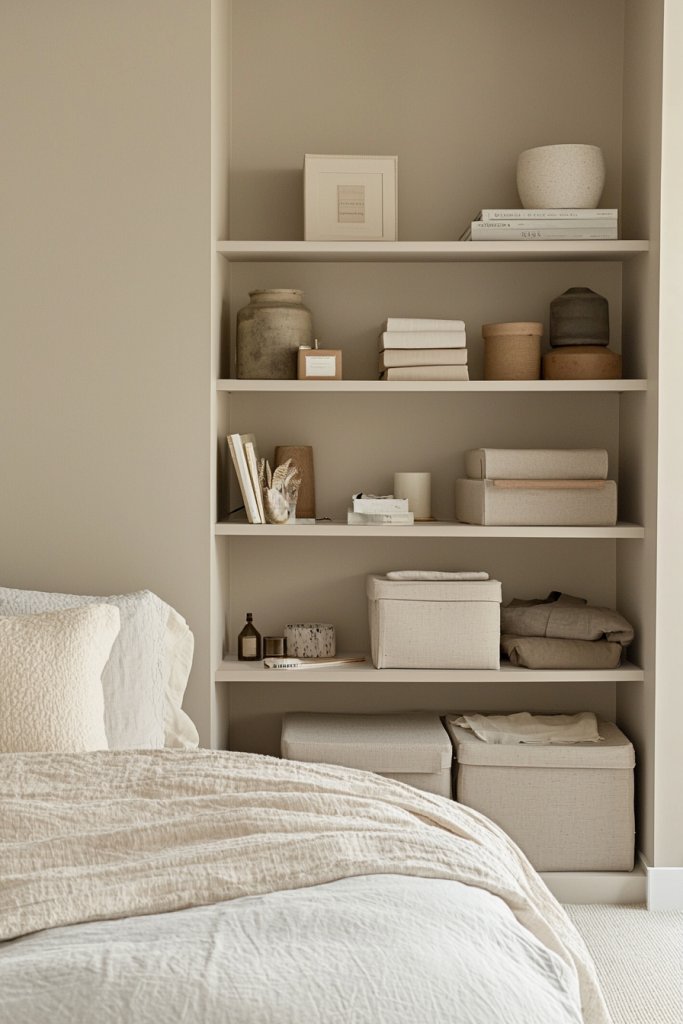
Built-in shelving seamlessly combines functionality with minimalist elegance, helping maintain a clutter-free, calming space. These discreet storage solutions blend into the walls, providing a place for essentials and decorative items without disrupting the room’s clean lines.
They’re perfect for showcasing subtle decor or storing everyday necessities out of sight, aligning perfectly with Japandi’s principle of simplicity. Visualize a wall with floating, recessed shelves painted in a matte, neutral tone that matches the wall color.
They hold simple ceramic vases, small sculptures, or neatly folded textiles, adding visual interest without overwhelming the room. The shelves are streamlined, with no visible brackets or hardware, creating a seamless look.
This setup emphasizes order and calm, allowing your space to breathe while offering easy access to your belongings. To implement, measure your wall space and plan for shallow, sturdy shelves that fit your storage needs.
Use materials like MDF or plywood finished with matte paint or veneer for a sleek appearance. For a DIY approach, install floating shelf brackets or concealed mounting systems for a clean look.
Keep the design minimal—limit decorative items to a few carefully chosen pieces—and regularly tidy your shelves to uphold the serene aesthetic. This smart storage option enhances your bedroom’s tranquility and practicality.
13. Add Layered Textiles with Fleece Throws and Linen Sheets

Layering textiles introduces tactile softness and visual depth, creating a cozy yet sophisticated bedroom atmosphere. Combining fleece throws and linen sheets offers a tactile contrast—plush and warm against crisp, breathable fabrics—that enhances comfort while maintaining the room’s understated elegance.
These textiles also add subtle color and texture, enriching the minimalist palette. Picture a bed dressed in crisp, white linen sheets with a slightly wrinkled, relaxed look.
Draped over the foot of the bed is a chunky knit fleece throw in a muted, earthy tone like taupe or soft gray, inviting touch and warmth. Complementing these layers are plush cushions in natural fabrics, creating a sense of abundance without clutter.
The combination of textures—smooth linen, textured fleece, and soft cushions—evokes serenity and invites you to unwind in a calm, tactile environment. For easy implementation, select high-quality linen sheets in neutral shades—think soft creams, light grays, or muted browns—and pair them with a fleece throw in a complementary tone.
Use a simple knot or fold to drape the throw across the bed for a relaxed look. Add a few matching cushions or an extra blanket for layered comfort. These textiles are affordable, easy to wash, and instantly elevate your bedroom’s inviting feel while aligning with Japandi’s minimalist ethos.
14. Utilize Sliding or Pocket Doors for Space Efficiency
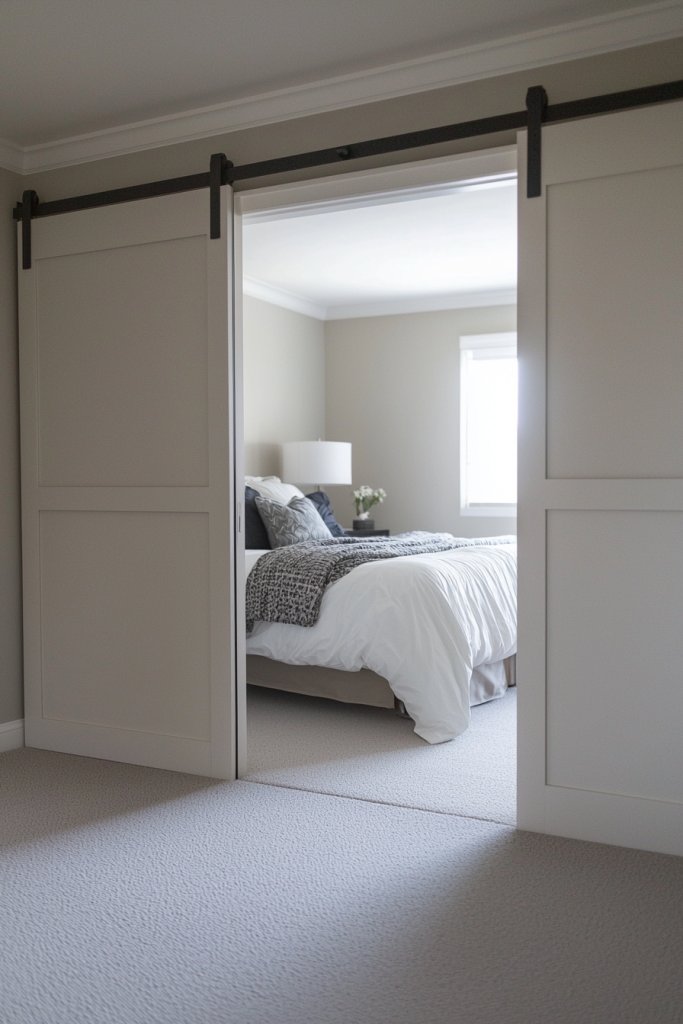
Sliding or pocket doors are a smart, space-saving solution that complements the clean, uncluttered aesthetic of Japandi design. These doors eliminate the need for swinging hinges, freeing up room for furniture or decorative elements, while adding a sleek, modern touch that emphasizes simplicity and functionality.
They also contribute to a seamless, minimalist flow between spaces. Imagine entering your bedroom through a smooth, matte black sliding door that disappears neatly into the wall when open.
The door’s flat surface and clean lines blend effortlessly with the neutral palette, creating a cohesive, calming environment. When closed, it offers privacy and a streamlined look, maintaining the room’s minimalist integrity.
The absence of traditional door hardware and the quiet operation enhance the tranquil atmosphere. To implement, choose a sliding or pocket door system compatible with your wall structure—many are DIY-friendly with kits available.
Opt for materials like MDF, veneer, or natural wood finishes in muted tones to match your decor. Ensure the track is installed level and securely, and consider a soft-close mechanism for a refined touch.
Minimal hardware and simple handles, or even handleless designs, will keep the look clean and modern. This upgrade boosts both functionality and aesthetic coherence in your Japandi bedroom.
15. Integrate Matte Black or Soft Metal Hardware for Subtle Contrast
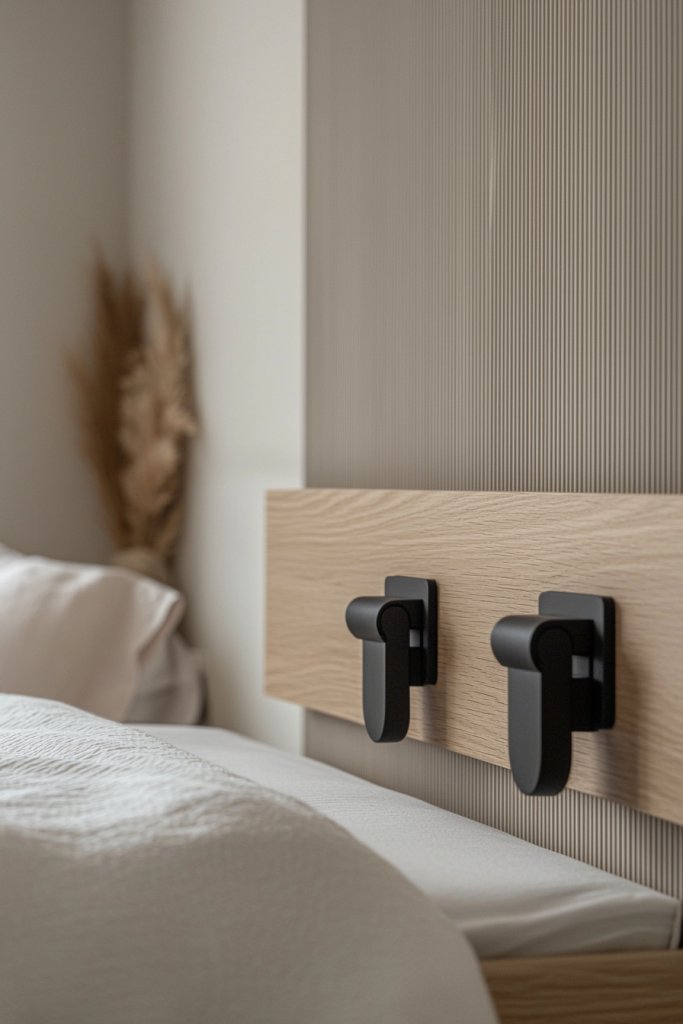
Incorporating matte black or soft metal hardware adds a refined, understated contrast that elevates the minimalist elegance of Japandi design. These hardware finishes provide subtle visual interest without overpowering the neutral palette, reinforcing the room’s sophisticated simplicity.
The muted tones also complement natural materials like wood and ceramics, creating harmony and balance. Picture sleek, matte black drawer pulls on a low-profile dresser or soft brushed metal handles on minimalist cabinetry.
These details catch the eye softly, offering a modern, chic touch that enhances the overall aesthetic. The contrast between the hardware and the light, neutral surfaces adds depth and dimension while remaining subtle.
When paired with other hardware elements, such as door handles or curtain rods, these finishes unify the space with a cohesive, contemporary look. To incorporate, select hardware in matte black, brushed nickel, or soft bronze—materials that are widely available at hardware stores or online.
Keep fixtures simple and handleless whenever possible to preserve the clean lines of your furniture. Use this hardware sparingly on key pieces to avoid visual clutter, ensuring each element contributes to the calm, minimalist vibe. These small but impactful details can significantly elevate the overall ambiance of your Japandi bedroom.
16. Choose Streamlined, Handleless Furniture for a Modern Look

In Japandi design, sleek, handleless furniture plays a crucial role in creating a clean, uncluttered aesthetic that exudes calm and simplicity. This approach not only looks sophisticated but also emphasizes the seamless flow of space, making your bedroom feel larger and more tranquil.
Imagine a bed frame with smooth, flat surfaces in muted tones like soft taupe or warm beige, with no visible handles or knobs. The furniture’s edges are gently rounded or sharply defined, contributing to a minimalist yet inviting atmosphere.
Floating nightstands with hidden hardware appear to hover effortlessly beside a low-profile platform bed, while storage units blend into the walls for an unobtrusive look. This furniture style relies on subtle design cues—like push-to-open mechanisms or groove pulls—that keep visual clutter at bay.
The overall effect is a space that feels cohesive, modern, and calming, perfect for unwinding. To implement this, choose furniture pieces labeled as “handleless” or “push-to-open” in stores or online.
Opt for materials like light oak, matte laminate, or painted MDF in neutral shades. For DIY options, consider installing magnetic or push-latch hardware on existing pieces or selecting modular furniture with clean lines. Focus on maintaining consistency in finishes and colors to reinforce the streamlined aesthetic, ensuring that your bedroom remains free of visual distractions and promotes a sense of peaceful order.
17. Incorporate Japanese-Inspired Tatami Mats for Floor Comfort
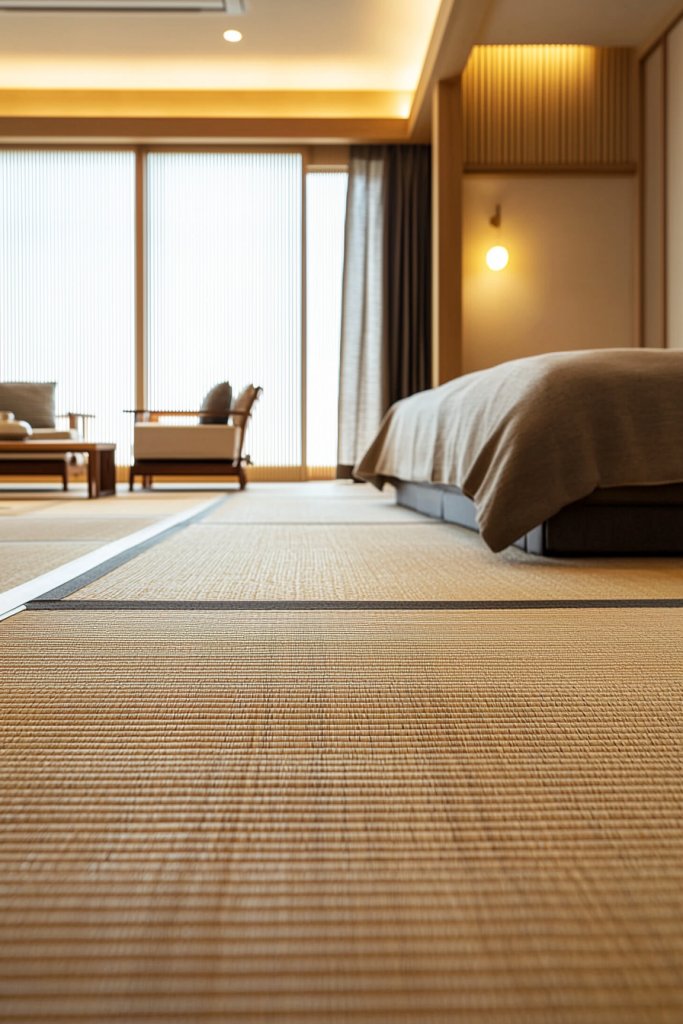
Adding traditional tatami mats to your bedroom floor infuses your space with authentic Japanese elegance and offers a natural, soft surface to walk or sit on. These mats instantly evoke a sense of calm and grounding, aligning perfectly with Japandi’s emphasis on natural materials and minimalist design.
Picture a bedroom with a rectangular or square tatami mat laid centrally, its woven straw surface in a gentle, earthy beige or light green hue. The texture is slightly rough yet comfortable underfoot, providing a sensory contrast to smooth wooden furniture.
The mats are edged with dark fabric borders or simple piping, creating a subtle visual boundary. When paired with low-profile beds or futon-style bedding, tatami mats set a serene, cozy tone that encourages relaxation and mindfulness.
Their natural scent and tactile feel enhance the room’s tranquil atmosphere, making it a true sanctuary for rest. To incorporate tatami mats, measure your space to determine the size and number needed for your layout.
They can be purchased from specialty Asian decor stores or online, often in standard sizes like 3×6 feet or 2×4 feet. For easier installation, lay the mats directly on your existing flooring or use a non-slip underlay to prevent shifting. Pair with simple, minimalist bedding and neutral tones to complete the look, creating a harmonious blend of tradition and modernity that feels both inviting and grounded.
18. Use Monochrome or Duotone Color Schemes for Visual Calm
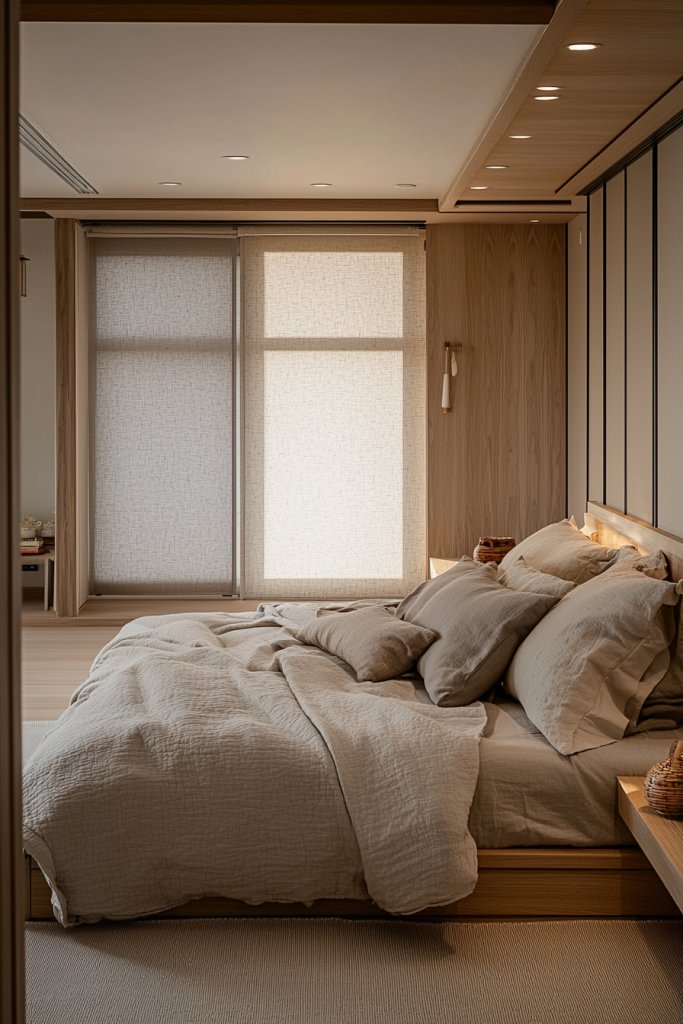
Employing monochrome or duotone color schemes in your bedroom instantly cultivates a sense of serenity and order, key principles in Japandi design. Limiting your palette to shades of one or two colors reduces visual noise and fosters a peaceful environment ideal for relaxation.
Visualize a bedroom in soft shades of gray and cream, with walls, bedding, and accessories all softly aligned within this restricted palette. The overall look is cohesive, with subtle variations in tone adding depth without disrupting the calm.
Incorporate textures like a plush throw, linen sheets, or a woven rug that complement the monochrome scheme, creating tactile interest while maintaining visual harmony. This restrained color approach makes the space feel more expansive and soothing, allowing your mind to rest without distraction.
The subtle contrast between shades also enhances the layered, minimalist aesthetic typical of Japandi interiors. To achieve this, select a dominant color and build your palette around it, choosing paint, textiles, and decor in varying shades and textures.
Use neutral tones like beige, taupe, or soft gray for walls and larger pieces, then add smaller accents like cushions or vases in darker or lighter shades of the same color. Keep accessories minimal and consistent in tone, and avoid overly bright or contrasting hues. This approach simplifies decorating and creates a tranquil, cohesive bedroom environment that promotes calm and mindfulness.
19. Add Subtle Geometric Patterns in Textiles and Decor Items

Introducing gentle geometric patterns into your bedroom textiles and decor adds visual interest without overwhelming the calm, minimalist aesthetic of Japandi design. These subtle shapes bring a modern touch while maintaining the overall sense of harmony and simplicity.
Imagine a soft, cream-colored throw pillow with a faint, muted hexagon pattern or a textured duvet cover featuring delicate triangles woven into the fabric. Small decorative objects like ceramic vases or woven baskets can display subtle geometric motifs, echoing the patterns found in nature or traditional Japanese textiles.
The key is to keep the patterns understated—think delicate lines, soft angles, and simple repeats—so they complement rather than compete with the room’s serene palette. This visual layering adds depth and personality to your space, making it feel thoughtfully curated yet peaceful.
To incorporate this idea, choose textiles in neutral tones with subtle geometric designs—like a linen bedspread with embossed squares or a set of cushions with faint chevron prints. Look for decor items such as ceramic bowls or sculptures with geometric patterns in matte finishes. Combining these elements thoughtfully creates a refined visual rhythm that enhances the room’s calm atmosphere, providing just enough visual intrigue to keep your space engaging without disturbing its tranquil essence.
20. Install Floating Shelves for Decorative and Functional Display
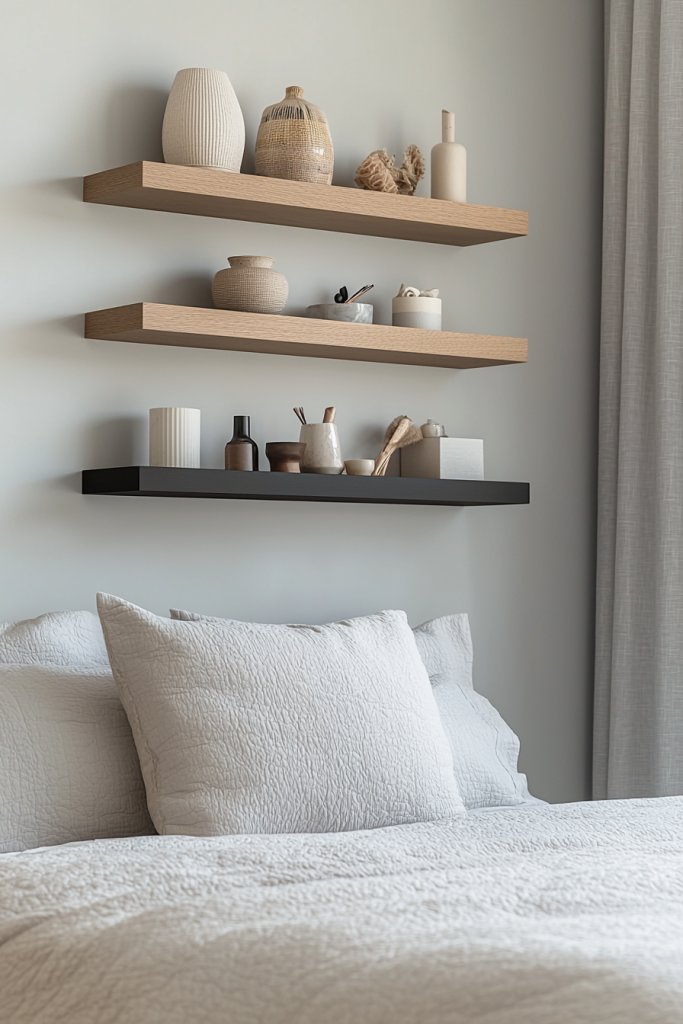
Floating shelves in a Japandi bedroom serve as elegant, space-saving platforms for displaying decorative objects and organizing essentials, all while maintaining the room’s clean and airy aesthetic. These sleek, wall-mounted surfaces add a modern touch and help keep clutter out of sight.
Picture narrow, matte black or light wood floating shelves installed above your bed or beside a window, holding carefully curated items like minimalist ceramic vases, small sculptures, or neatly folded textiles. The absence of visible brackets creates a seamless look, making the shelves blend effortlessly into the wall.
Their simple design emphasizes the room’s openness and encourages a clutter-free environment, which is essential for mental clarity. When arranged thoughtfully, these shelves become focal points that showcase your personal style within the understated Japandi framework, adding layers of visual interest without disrupting the calm.
To implement, select floating shelves made from natural wood or matte-finished materials that complement your furniture. Use a level and appropriate anchors to secure them safely on your wall, spacing them at varying heights for a dynamic display.
Decorate with a few well-chosen objects—like small ceramic planters, candles, or framed quotes—keeping the arrangement uncluttered. This simple addition enhances both the functionality and aesthetic appeal of your bedroom, creating a balanced and tranquil space to enjoy.
21. Incorporate Natural Stone Elements for a Grounding Effect
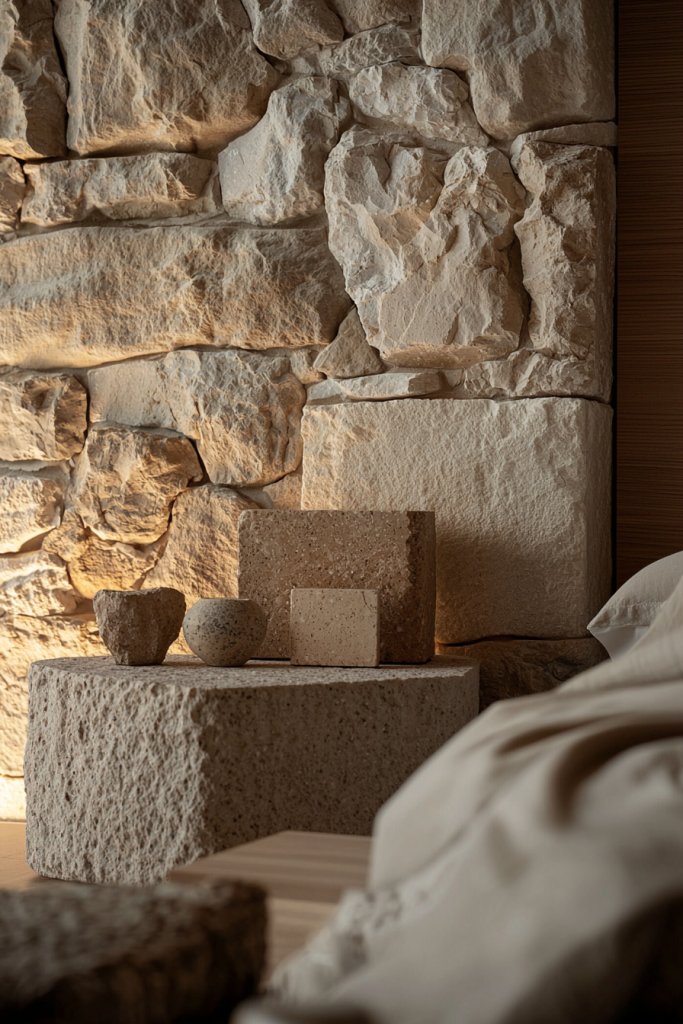
Adding natural stone elements to your Japandi bedroom creates a strong sense of grounding and connection to nature, which enhances the calming atmosphere. These stones can be incorporated through accent walls, decorative panels, or subtle surface details, bringing in earthy textures that evoke stability and tranquility.
The visual appeal lies in their organic, irregular shapes and varied hues, from soft grays and warm beiges to deep charcoal, which complement the minimalist aesthetic perfectly. When touched, stone surfaces provide a cool, tactile contrast to softer textiles, adding depth and sensory richness to the space.
This approach transforms the bedroom into a serene retreat that feels both sophisticated and rooted in nature. Visualize a sleek, low-profile bed framed by a feature wall made of large, slabs of smooth, matte stone in muted tones.
The stones are arranged to emphasize their natural textures, with some areas left raw and others polished for contrast. The space is illuminated with soft, diffused lighting that highlights the subtle veins and imperfections in the stone, creating gentle shadows that dance over the surface.
Complementing this, small stone sculptures or coasters on bedside tables add refined touches without cluttering the space. The overall effect is a harmonious blend of raw earthiness and modern minimalism that invites relaxation and mindfulness.
To incorporate this into your bedroom, start by choosing large stone tiles or slabs with subdued colors and matte finishes—think slate, limestone, or granite. You can install them as a feature wall behind your bed, or use smaller stones for decorative accents on shelves or around the bed frame.
For a DIY approach, consider adhesive-backed stone veneer panels that are easier to install. Pair the stones with neutral-colored bedding and simple wooden furniture to maintain the clean, minimalist vibe. Keep the space uncluttered and let the natural textures be the focal point, creating a serene, grounded sanctuary.
22. Use Woven Baskets for Hidden Storage and Textural Interest
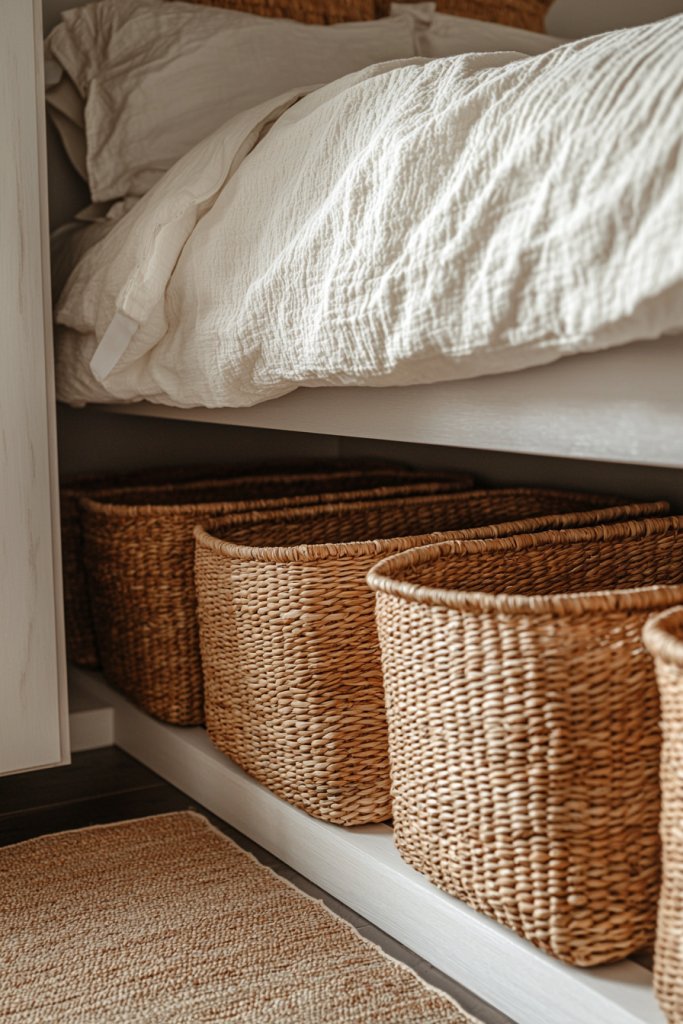
Woven baskets are a quintessential element of Japandi style, offering both functional storage and natural texture that adds warmth and visual interest. These versatile containers can be used to hide away extra blankets, clothes, or bedside essentials while contributing a handcrafted, artisanal feel to the room.
Their woven patterns and earthy tones—such as tan, beige, or charcoal—complement neutral color schemes beautifully. Plus, their tactile texture contrasts gently with smooth surfaces like wood or ceramics, creating a layered, inviting atmosphere that echoes the natural simplicity of Japandi design.
Imagine a set of large, tightly woven baskets placed under the bed or tucked beside a sleek wooden dresser. Their rounded shapes and textured surfaces invite touch, and their open tops make it easy to access stored items.
You might also add smaller baskets on open shelves or beside seating areas to hold magazines, cozy throws, or slippers. The sound of wicker or rattan gently creaking when moved adds a subtle sensory element, enriching the tranquil environment.
These baskets subtly soften the room’s clean lines while providing practical solutions that keep clutter out of sight. To implement, select baskets made from natural fibers such as rattan, seagrass, or wicker, choosing sizes to match your storage needs.
For budget-friendly options, look for store-bought options or DIY projects using cane or jute ropes. Incorporate them into your bedroom by placing one under your bed, stacking a couple on each other, or situating them on open shelving.
For added cohesion, choose baskets in neutral shades that blend seamlessly with your bed linens and furniture. This simple addition enhances both organization and the tactile beauty of your space, making it feel serene and thoughtfully curated.
23. Choose Soft, Diffused Lighting with Dimmer Options
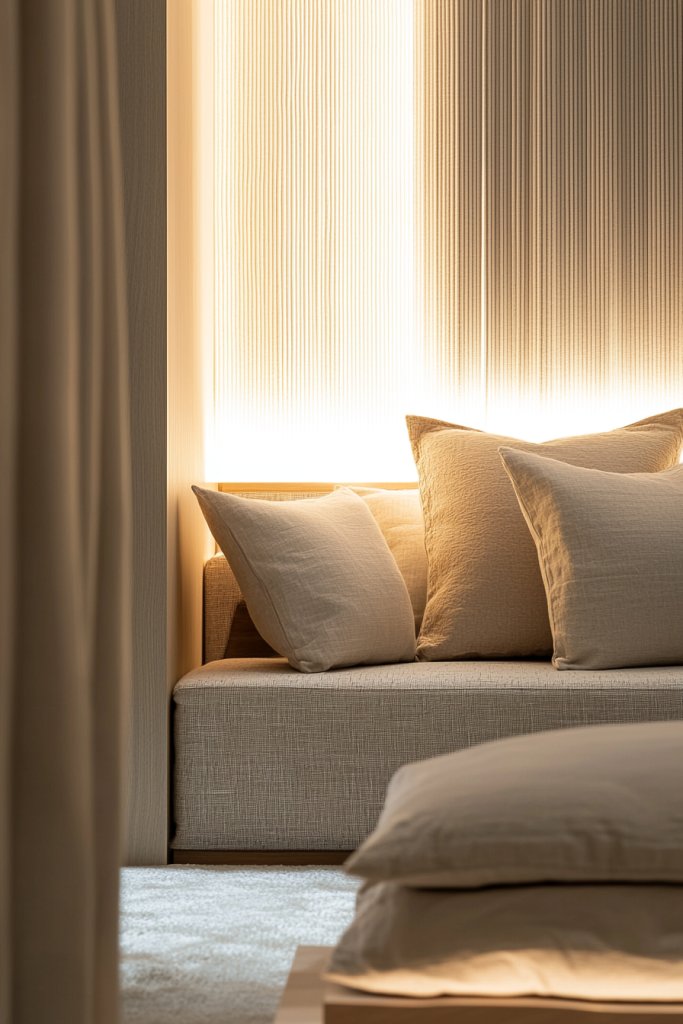
Lighting plays a crucial role in establishing a calm, inviting atmosphere in a Japandi bedroom, and soft, diffused light is essential for creating a tranquil space. Instead of harsh overhead lighting, opt for gentle, ambient illumination that gently bathes the room in warm, even light.
Installing dimmer switches allows you to adjust brightness according to your mood or time of day, fostering relaxation during evenings or energizing mornings. This layered lighting approach not only elevates the aesthetic but also helps to reduce visual clutter, emphasizing the room’s clean lines and subtle textures.
Picture a bedroom illuminated by a combination of light sources: a paper lantern with a warm glow hanging from the ceiling, a small table lamp with a fabric shade on a bedside table, and perhaps a hidden LED strip behind a headboard for subtle backlighting. The light is soft, warm, and evenly dispersed, avoiding glare and creating a cozy, inviting environment.
The gentle glow enhances the earthy tones of your decor, casting delicate shadows that add depth and serenity. It’s a space that feels calm and safe, perfect for unwinding or sleeping peacefully.
To achieve this, select lighting fixtures with fabric or paper shades that diffuse light naturally, such as rice paper lanterns or linen-covered table lamps. Use warm-colored bulbs (2700K–3000K) for a cozy ambiance.
For maximum flexibility, install dimmer switches on your main light sources—many modern fixtures come with compatible dimmers or can be upgraded easily. Incorporate multiple light sources at different levels to create layers of glow, ensuring the room feels soft and inviting at all times. This simple lighting strategy transforms your bedroom into a sanctuary of calm, perfect for relaxing or unwinding after a long day.
24. Add Elegant, Simple Mirrors to Enhance Light and Space
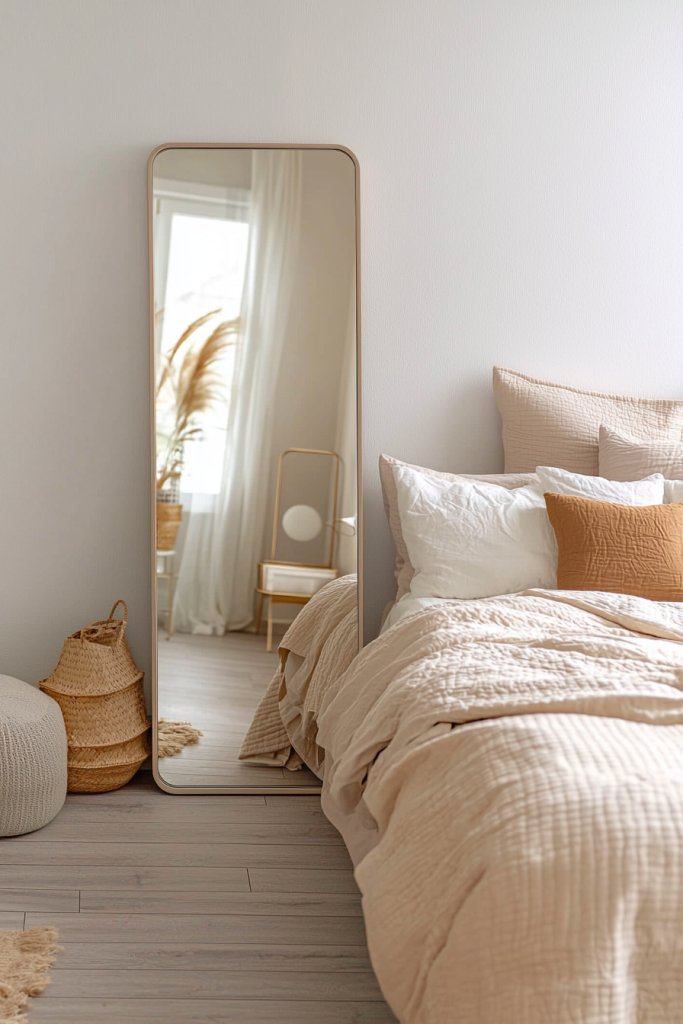
Mirrors are a vital element in Japandi design, serving both functional and aesthetic purposes by amplifying natural light and creating a sense of spaciousness. An elegant, frameless or slim-framed mirror placed strategically can reflect sunlight, making the room appear larger and more luminous.
The key is choosing simple, understated designs that complement the minimalist ethos—think round or rectangular shapes with clean edges and neutral frames, or even frameless options for a seamless look. Imagine a large, oval mirror leaning against a wall or mounted above a sleek wooden dresser.
Its glass surface reflects the soft, diffused lighting and the calming neutral palette of the room, instantly making the space feel brighter and more open. The mirror’s simple design ensures it doesn’t compete with other decor but rather enhances the overall tranquil aesthetic.
When positioned thoughtfully, it also provides a practical spot for dressing while contributing to the room’s visual harmony and serenity. To incorporate, opt for a mirror with a thin metal or wood frame in matte black, soft gold, or natural wood tones to keep the look minimalist.
Place it opposite a window or near a light source to maximize reflection of natural light. Consider a wall-mounted or leaning style depending on your space and preference—leaning mirrors are easy to reposition and can add a relaxed vibe. Keep the surrounding decor simple—perhaps a small potted plant or a few candles—to allow the mirror to serve as a subtle but powerful focal point that elevates your bedroom’s sense of openness and calm.
25. Keep Decor Minimal and Thoughtfully Curated for a Tranquil Atmosphere
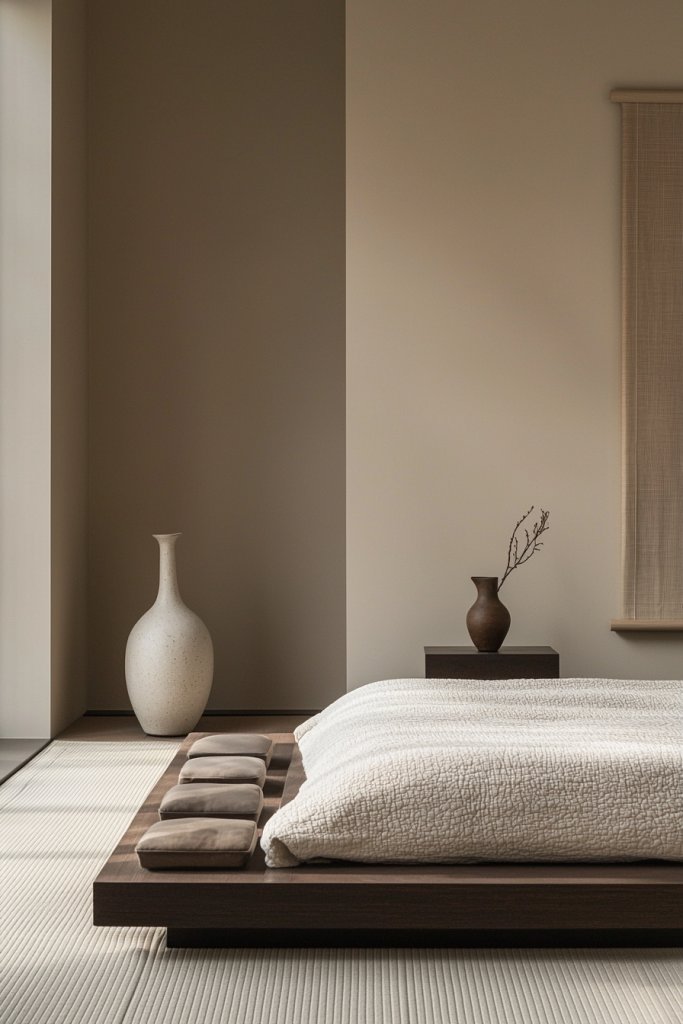
A hallmark of Japandi style is the artful restraint in decor—less is more. Maintaining a minimal yet thoughtfully curated selection of decor items ensures your bedroom remains a peaceful retreat free from visual clutter.
Each piece should serve a purpose or evoke a sense of calm, whether it’s a simple ceramic vase, a textured throw, or a subtle sculpture. This deliberate approach fosters a serene environment where every element contributes to the overall harmony, making the space feel balanced and restorative.
Visualize a bedroom with just a few carefully chosen accents: a smooth ceramic vase with a single dried branch, a cozy linen throw in a neutral tone, and a small, understated sculpture on a shelf. These elements are spaced intentionally, allowing each to breathe and avoiding overcrowding.
The overall look is clean and uncluttered, with a soothing color palette and natural textures that promote relaxation. The key is selecting quality pieces that resonate personally, creating an environment that feels both beautiful and peaceful.
To achieve this, start by removing unnecessary items and focus on a few statement decor pieces. Choose objects made from natural materials like ceramics, wood, or woven textiles that align with your color scheme.
Keep surfaces clear—use hidden storage solutions for everyday essentials—and resist the urge to over-decorate. This approach results in a calm, balanced bedroom where every detail enhances your sense of tranquility, making it easier to unwind and enjoy your personal sanctuary.
Conclusion
With these 25 Japandi bedroom design ideas, you have a versatile toolkit to craft a serene, stylish retreat that balances simplicity and warmth. From minimalist furniture and neutral palettes to natural textures and subtle details, each element contributes to a calming atmosphere.
Don’t hesitate to experiment and personalize these concepts to create a space that truly reflects tranquility and refined elegance. Start transforming your bedroom today and embrace the peaceful, harmonious vibe of Japandi style.
Leave a Reply